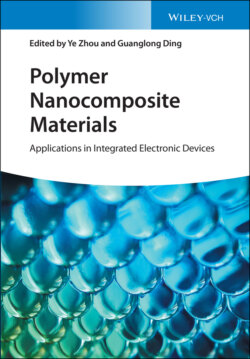Читать книгу Polymer Nanocomposite Materials - Группа авторов - Страница 33
2.2.2 Solution Blending
ОглавлениеAlthough melt blending is a useful and feasible processing method for the large-scale industrial production of the CPCs, the volume concentration of conductive particles is usually higher than 5% to obtain the composite with a high conductivity [45]. Such a high content of fillers would largely increase the melt viscosity [46, 47] and thus make the processing less smooth and also increase the cost of the material fabrication. As an alternative, solution mixing method can tackle this issue, because the nanofillers can be diluted in solvent to achieve relatively good dispersion [48, 49].
Solution mixing refers to a process for preparation of CPCs through mixing conductive elements and polymer matrix in a solvent, followed by cooling and solvent removal. Generally, this fabrication process contains three key steps: (i) preparation of filler suspension in a suitable solvent, (ii) mixing filler suspension with polymer, and (iii) precipitation or solvent evaporation of the mixed solution. While the majority of conductive fillers, especially carbon-based fillers (e.g. CNTs, graphene, and carbon black) show undesired dispersion in organic solvent due to their large specific surface area and high degree of graphitization thus low surface energy. Herein, it is difficult to get a uniformly dispersed suspension of carbon-based fillers just by mechanical stirring. Thus, powerful ultrasonication is often adopted to assist the nanofiller dispersion in a polymer solution [50–52]. In many cases, chemical modification or the dispersant is required. For instance, acid (such as sulfuric and/or nitric) is often used to modify the CNTs, and the graphitized structure of the CNTs is partially damaged and oxygen containing functional groups can be grafted onto the filler surface through covalent bonding [53, 54]. These functional groups can effectively promote the nanofiller dispersion in the solution due to the interaction (e.g. hydrogen bond) between fillers and solvent [16, 55].
Although covalent bonding is permanent and mechanically stable, chemical reaction can also, to a large degree, damage the sp2 conformation of the carbon atom, thereby disrupting the conjugation of the CNT wall. As a result, thermal, electrical, and mechanical properties of the chemically modified CNTs decreased dramatically, as compared with the pristine nanotubes [56]. To preserve the integrity of CNT microstructure while at the same time improve CNT dispersity, the noncovalent method to functionalize CNTs has received increasing attention, because the surface structure of the nanofillers is preserved and thus the physical and electrical properties of the nanofillers are preserved [19, 57]. Generally, the surfactants with perfect solubility with the solvent are usually used in noncovalent method, and these molecules are able to wrap CNTs, and the affinity between CNTs and the solvent is thus enhanced [58].
In recent years, amphiphilic molecules like polymers are non-covalently attached on the surface of nanofillers to overcome their aggregation [59, 60]. For example, poly(vinylpyrrolidone) (PVP) and polystyrene sulfonate (PSS) were used to improve the solubility of CNT in water and thus the CNT dispersion in polymer matrix [e.g. polyvinyl alcohol (PVA) and polyethylene oxide (PEO)] [61, 62]. Lee et al. [63] successfully dispersed MWCNTs with the concentration as high as 6.7 wt% in a PEO solution by attaching the amphiphilic poly(styrenesulfonic acid-graft-aniline) (PSS-g-ANI) to the surface of MWCNTs. The attachment of PSS-g-ANI has dramatically enhanced the dispersion of MWCNTs and dispersion of 1%, 10%, 20%, 30%, and 40% MWCNT/PEO solutions still remains homogeneous even after three days. Deoxyribonucleic acid (DNA) as a representative biopolymer has now also been considered as a powerful dispersing agent to disentangle strongly bundled CNTs in an aqueous solution, resulting from DNA's strong ability to wrap around the sidewalls of CNTs [64, 65]. It was reported that CNTs were individually dispersed in the DNA solution, and the uniform dispersion could be preserved in the polymer/CNTs/solvent ternary solution [65]. In PEO nanofiber composite, under the DNA assistant dispersion, double-walled carbon nanotubes (DCNTs) were finally trapped along the axis of the PEO nanofiber and acted as mechanically reinforcing filler and an electrical conductor [57]. The morphology of PEO nanofiber web consisting of long, homogeneous nanofibers with a diameter of <100 nm was obtained even with the content of 5% DNA-dispersed double-walled carbon nanotubes (DWNTs) shown in Figure 2.2a,b. Also, the modulus and tensile strength were largely improved by adding individually DNA dispersed DWNTs (Figure 2.2c).
Figure 2.2 (a, b) The PEO/DNA nanofiber webs containing 5% DNA-dispersed DWNTs. (c) Stress–strain curves for nanofiber webs of pure PEO, PEO/DNA, and PEO/DNA/DWNT. Source: (a)–(c) Reproduced with permission. [57] Copyright 2013, American Chemical Society.
